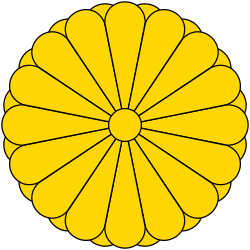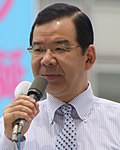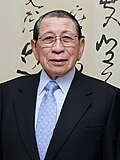| Northern Japan |
|---|
| Prefecture | Seats up | Incumbents | Party | Result | Candidates
(Party – endorsements)
Vote share |
|---|
| Hokkaidō | 2 | Chūichi Date | LDP | Incumbents re-elected
DPJ gains top tōsen | | Katsuya Ogawa (DPJ) 36.0%
Chūichi Date (LDP – Kōmeitō) 26.8%
Kaori Tahara (I – DPJ, PNP, NPD) 22.0%
Kazuya Hatayama (JCP) 7.3%
Hideyoshi Hashiba (I) 3.7%
Takao Asano (SDP) 2.8%
Masayuki Arakawa (I) 0.8%
Nobuhito Sendai (Ishin Seito Shimpū) 0.6% |
| Katsuya Ogawa | DPJ | |
| Aomori | 1 | Tsutomu Yamazaki | LDP | Incumbent lost re-election
DPJ pickup | Kōji Hirayama (DPJ – PNP) 49.0%
Tsutomu Yamazaki (LDP – Kōmeitō) 39.9%
Hidehiko Watanabe (SDP) 6.0%
Hiroaki Takayanagi (JCP) 5.1% |
| Iwate | 1 | Tatsuo Hirano | DPJ | Incumbent re-elected | | Tatsuo Hirano (DPJ – PNP) 62.6%
Shōichirō Chida (LDP – Kōmeitō) 25.2%
Masahiro Isawa (SDP) 6.8%
Akio Wakayama (JCP) 5.4% |
| Miyagi | 2 | Tomiko Okazaki | DPJ | Incumbents re-elected | | Tomiko Okazaki (DPJ) 52.7%
Jirō Aichi (LDP – Kōmeitō) 34.5%
Mikio Katō (JCP) 6.9%
Kiyomi Kishida (SDP) 5.9% |
| Jirō Aichi | LDP | |
| Akita | 1 | Katsutoshi Kaneda | LDP | Incumbent lost re-election
DPJ pickup | Daigo Matsuura (I – DPJ, SDP) 50.4%
Katsutoshi Kaneda (LDP) 43.6%
Satoshi Suzuki (JCP) 6.0% |
| Yamagata | 1 | Masatoshi Abe | LDP | Incumbent retired
DPJ pickup | Yasue Funayama (DPJ – PNP) 57.3%
Mieko Shinohara (LDP – Kōmeitō) 36.8%
Masayuki Satō (JCP) 5.9% |
| Fukushima | 2 | Toyoaki Ōta | LDP | Incumbents retired
LDP and DPJ hold
DPJ gains top tōsen | | Emi Kaneko (DPJ) 49.9%
Masako Mori (LDP – Kōmeitō) 37.0%
Shizue Miyamoto (JCP) 7.8%
Uzen Ogawa (SDP) 5.4% |
| Hiroko Wada | DPJ | |
| Eastern and Central Japan |
|---|
| Prefecture | Seats up | Incumbents | Party | Result | Candidates
(Party – endorsements)
Vote share |
|---|
| Ibaraki | 2 | Yasu Kanō | LDP | Incumbents retired
LDP and DPJ hold
DPJ gains top tōsen | | Yukihisa Fujita (DPJ) 43.4%
Tamon Hasegawa (LDP) 34.3%
Masao Ishizu (I) 9.2%
Takeo Taya (JCP) 6.9%
Toshitaka Kudō (PNP) 4.2%
Hiromitsu Mutō (Kyōsei) 1.9% |
| Moto Kobayashi | DPJ | |
| Tochigi | 1 | Masayuki Kunii | LDP | 1 seat lost by reapportionment
LDP incumbent lost re-election
DPJ incumbent re-elected | | Hiroyuki Tani (DPJ – PNP) 53.9%
Masayuki Kunii (LDP – Kōmeitō) 41.4%
Kazunori Koike (JCP) 4.7% |
| Hiroyuki Tani | DPJ |
| Gunma | 1 | Ichita Yamamoto | LDP | 1 seat lost by reapportionment
DPJ incumbent retired
LDP incumbent re-elected | | Ichita Yamamoto (LDP – Kōmeitō) 62.0%
Kōji Fukuda (PNP – DPJ) 27.0%
Hiroaki Sakai (JCP) 11.1% |
| Giichi Tsunoda | DPJ |
| Saitama | 3 | Taizō Satō | LDP | DPJ incumbent re-elected
LDP incumbent retired
LDP hold
Kōmeitō incumbent lost re-election
DPJ pickup
DPJ gains top tōsen | | Kuniko Kōda (DPJ) 23.5%
Toshiharu Furukawa (LDP) 21.6%
Ryūji Yamane (DPJ) 21.0%
Hiroshi Takano (Kōmeitō) 19.7%
Sumiko Ayabe (JCP) 8.7%
Etsuko Matsuzawa (SDP) 3.3%
Tetsuo Sawada (PNP) 2.3% |
| Hiroshi Takano | Kōmeitō | |
| Ryūji Yamane | DPJ | |
| Chiba | 3 | Hiroyuki Kurata | LDP | Incumbents retired
LDP and DPJ hold
DPJ gains top tōsen | | Hiroyuki Nagahama (DPJ) 25.2%
Jun'ichi Ishii (LDP – Kōmeitō) 20.5%
Ken Kagaya (DPJ) 18.1%
Takaki Shirasuka (LDP – Kōmeitō) 14.7%
Fumiko Asano (JCP) 8.1%
Susumu Honma (I) 4.9%
Kazumi Aoki (SDP) 4.7%
Michiko Iwabuchi (PNP) 3.8% |
| Akira Imaizumi | DPJ | |
| | 1 seat gained by reapportionment
DPJ pickup |
| Tokyo | 5 | Sanzō Hosaka | LDP | JCP incumbent retired
DPJ and Kōmeitō incumbents re-elected
LDP incumbent lost re-election
LDP hold
DPJ pickup
DPJ gains top tōsen | | Masako Ōkawara (DPJ) 18.4%
Natsuo Yamaguchi (Kōmeitō) 13.5%
Kan Suzuki (DPJ) 13.2%
Tamayo Marukawa (LDP) 11.7%
Ryūhei Kawada (I) 11.6%
Sanzō Hosaka (LDP) 11.0%
Tomoko Tamura (JCP) 9.4%
Hitomi Sugiura (SDP) 3.5%
Keiichirō Nakamura (PNP) 2.6%
Dr. NakaMats (I) 1.6%
Kishō Kurokawa (Kyōsei) 1.2%
Yūko Tōjō (I) 1.0%
Nobuyuki Suzuki (Ishin) 0.4%
Kikuo Suda (Halve Parliament) 0.3 %
Toshiaki Kanda (I) 0.2%
5 other candidates 0.5% |
| Natsuo Yamaguchi | Kōmeitō | |
| Kan Suzuki | DPJ | |
| Yasuo Ogata | JCP | |
| | 1 seat gained by reapportionment
Independent pickup |
| Kanagawa | 3 | Yutaka Kobayashi | LDP | LDP incumbent re-elected
LDP incumbent retires
Kōmeitō incumbent lost re-election
2 DPJ pickups
DPJ gains top tōsen
post-election: LDP incumbent disqualified → Kōmeitō hold (see note) | | Hiroe Makiyama (DPJ) 25.4%
Yutaka Kobayashi (LDP) 22.5%
Masahi Mito (DPJ) 19.7%
Akira Matsu (Kōmeitō) 17.4%
Kimie Hatano (JCP) 9.7%
Shigeru Wada (SDP) 3.2%
Sachiko Saitō (PNP) 1.5%
Toshimori Mizoguchi (Ishin) 0.5% |
| Akira Matsu | Kōmeitō | |
| Yoriko Kawaguchi | LDP | |
| Niigata | 2 | Takahiro Kuroiwa | DPJ | DPJ incumbent re-elected
DPJ incumbent lost re-election
LDP pickup | | Ichirō Tsukada (LDP – Kōmeitō) 32.1%
Yūko Mori (DPJ – PNP) 28.3%
Takahiro Kuroiwa (DPJ) 27.4%
Akiko Yamamoto (SDP) 7.2%
Katsutoshi Takeda (JCP) 4.3%
Mitsumasa Kusuhara (I) 0.6% |
| Yūko Mori | DPJ | |
| Toyama | 1 | Kōtarō Nogami | LDP | Incumbent lost re-election
PNP pickup | Takashi Morita (I – DPJ, SDP, PNP) 50.1%
Kōtarō Nogami (LDP) 45.7%
Kazuyuki Izumino (JCP) 4.2% |
| Ishikawa | 1 | Tetsuo Kutsukake | LDP | Incumbent retired
DPJ pickup | Yasuo Ichikawa (DPJ – PNP) 46.9%
Tomirō Yata (LDP – Kōmeitō) 46.2%
Mikiko Chikamatsu (JCP) 4.9%
Shigeru Hamasaki (I) 2.0% |
| Fukui | 1 | Ryūji Matsumura | LDP | Incumbent re-elected | | Ryūji Matsumura (LDP – Kōmeitō) 47.5%
Seizō Wakaizumi (DPJ – PNP) 46.8%
Kazuo Yamada (JCP) 5.7% |
| Yamanashi | 1 | Mahito Nakajima | LDP | Incumbent retired
DPJ pickup | Harunobu Yonenaga (DPJ – PNP) 55.3%
Kaname Irikuri (LDP – Kōmeitō) 37.1%
Hitoshi Hanada (JCP) 7.5% |
| Nagano | 2 | Hiromi Yoshida | LDP | Incumbents re-elected
DPJ gains top tōsen | | Yūichirō Hata (DPJ) 47.9%
Hiromi Yoshida (LDP – Kōmeitō) 26.8%
Sanae Nakano (JCP) 17.3%
Hiroji Nakagawa (SDP) 8.0% |
| Yūichirō Hata | DPJ | |
| Gifu | 2 | Tsuyako Ōno | LDP | DPJ incumbent re-elected
LDP incumbent retired
LDP hold | | Takao Fujii (I – LDP, Kōmeitō) 46.1%
Kenji Hirata (DPJ) 44.1%
Takao Katō (JCP) 9.8% |
| Kenji Hirata | DPJ | |
| Shizuoka | 2 | Yutaka Takeyama | LDP | DPJ incumbent re-elected
LDP incumbent retired
LDP hold
DPJ gains top tōsen | | Kazuya Shinba (DPJ) 47.1%
Takao Makino (LDP – Kōmeitō) 31.4%
Ichi Kibe (I) 8.6%
Takashige Hiraga (JCP) 7.9%
Hirokazu Tsuchida (I) 4.9% |
| Kazuya Shinba | DPJ | |
| Aichi | 3 | Seiji Suzuki | LDP | LDP and DPJ incumbents re-elected
Kōmeitō incumbent lost re-election
DPJ pickup
DPJ gains top tōsen | | Kōhei Ōtsuka (DPJ) 26.4%
Seiji Suzuki (LDP) 22.0%
Kuniko Tanioka (DPJ – PNP) 21.6%
Tamotsu Yamamoto (Kōmeitō) 17.6%
Hiroko Hatta (JCP) 8.8%
Ryōhei Hirayama (SDP) 2.1%
Takashi Hyōdō (I) 0.7%
Masaji Tsuge (Ishin) 0.4%
Arakawa Kōtarō (Kyōsei) 0.4% |
| Kōhei Ōtsuka | DPJ | |
| Tamotsu Yamamoto | Kōmeitō | |
| Mie | 1 | Chiaki Takahashi | DPJ | Incumbent re-elected | | Chiaki Takahashi (DPJ – PNP) 59.4%
Kōhei Onozaki (LDP – Kōmeitō) 33.0%
Takeshi Nakano (JCP) 7.7% |
| Western Japan |
|---|
| Prefecture | Seats up | Incumbents | Party | Result | Candidates
(Party – endorsements)
Vote share |
|---|
| Shiga | 1 | Hidetoshi Yamashita | LDP | Incumbent lost re-election
DPJ pickup | Hisashi Tokunaga (DPJ – PNP) 50.2%
Hidetoshi Yamashita (LDP – Kōmeitō) 40.6%
Ikuo Tsubota (JCP) 9.2% |
| Kyōto | 2 | Yoshihiro Nishida | LDP | DPJ incumbent re-elected
LDP incumbent retired
LDP hold
DPJ gains top tōsen | | Kōji Matsui (DPJ) 43.6%
Shōji Nishida (LDP – Kōmeitō) 31.4%
Mariko Narumiya (JCP) 23.9%
Toyokazu Ōkida (Ishin) 1.1% |
| Kōji Matsui | DPJ | |
| Ōsaka | 3 | Shūzen Tanigawa | LDP | LDP and Kōmeitō incumbents re-elected
DPJ incumbent retired
DPJ hold
DPJ gains top tōsen | | Satoshi Umemura (DPJ) 33.2%
Kazuyoshi Shirahama (Kōmeitō) 21.7%
Shūzen Tanigawa (LDP) 18.9%
Takeshi Miyamoto (JCP) 15.2%
Junko Shiraishi (PNP) 4.2%
Ryōichi Hattori (SDP – 9-jō Net) 3.7%
Takeshi Ueda (I) 1.4%
Shōnosuke Hayashi (I) 1.3%
Yoshio Ōtani (I) 0.5% |
| Kazuyoshi Shirahama | Kōmeitō | |
| Takashi Yamamoto | DPJ | |
| Hyōgo | 2 | Yoshitada Kōnoike | LDP | Incumbents re-elected
DPJ gains top tōsen | | Yasuhiro Tsuji (DPJ) 44.1%
Yoshitada Kōnoike (LDP – Kōmeitō) 34.9%
Terufumi Horiuchi (JCP) 10.9%
Kazumi Hara (9-jō Net) 7.5%
Yukimitsu Nishida (I) 2.6% |
| Yasuhiro Tsuji | DPJ | |
| Nara | 1 | vacant
(last held by Shōgo Arai, LDP) | DPJ pickup | Tetsuji Nakamura (DPJ – PNP) 52.5%
Masatake Matsui (LDP – Kōmeitō) 36.9%
Atsuko Nakamura (JCP) 10.6% |
| Wakayama | 1 | Hiroshige Sekō | LDP | Incumbent re-elected | | Hiroshige Sekō (LDP – Kōmeitō) 52.3%
Naoto Sakaguchi (DPJ – PNP) 38.2%
Hideaki Kunishige (JCP) 9.5% |
| Tottori | 1 | Takayoshi Tsuneda | LDP | Incumbent lost re-election
DPJ pickup | Yoshihiro Kawakami (DPJ – PNP) 51.5%
Takayoshi Tsuneda (LDP – Kōmeitō) 41.4%
Shōzō Ichitani (JCP) 7.2% |
| Shimane | 1 | Shuntarō Kageyama | LDP | Incumbent lost re-election
PNP pickup | Akiko Kamei (PNP – DPJ) 50.9%
Shuntarō Kageyama (LDP – Kōmeitō) 43.6%
Kazuhiko Gotō (JCP) 5.5% |
| Okayama | 1 | Toranosuke Katayama | LDP | Incumbent lost re-election
DPJ pickup | Yumiko Himei (DPJ – PNP) 49.4%
Toranosuke Katayama (LDP – Kōmeitō) 44.2%
Kanji Uemoto (JCP) 4.7%
Fukuji Hayashi (I) 1.0%
Makoto Kitagawa (Ishin) 0.6% |
| Hiroshima | 2 | vacant
(last held by Takeaki Kashimura, LDP) | Incumbent re-elected
DPJ pickup
DPJ gains top tōsen | | Kōji Satō (DPJ – PNP) 43.9%
Kensei Mizote (LDP – Kōmeitō) 30.0%
Miyoko Kōno (I) 15.3%
Satoshi Fujimoto (JCP) 4.9%
Yui Yoshinaga (I) 4.2%
Jun'ichi Fukumoto (I) 1.7% |
| Kensei Mizote | LDP | |
| Yamaguchi | 1 | Yoshimasa Hayashi | LDP | Incumbent re-elected | | Yoshimasa Hayashi (LDP – Kōmeitō) 56.7%
Takako Tokura (DPJ – PNP) 36.2%
Sadayoshi Yoshida (JCP) 7.1% |
| Tokushima | 1 | Shūji Kitaoka | LDP | Incumbent lost re-election
DPJ pickup | Tomoji Nakatani (DPJ) 54.0%
Shūji Kitaoka (LDP – Kōmeitō) 39.3%
Atsushi Hanaoka (JCP) 6.7% |
| Kagawa | 1 | Kenji Manabe | LDP | Incumbent lost re-election
DPJ pickup | Emiko Uematsu (DPJ) 53.6%
Kenji Manabe (LDP – Kōmeitō) 40.6%
Michiko Chikaishi (JCP) 5.8% |
| Ehime | 1 | Katsutsugu Sekiya | LDP | Incumbent lost re-election
DPJ pickup | Toshirō Tomochika (I – DPJ, SDP, PNP) 51.3%
Katsutsugu Sekiya (LDP – Kōmeitō) 43.1%
Katsuhiko Tanaka (JCP) 5.5% |
| Kōchi | 1 | Kōhei Tamura | LDP | Incumbent lost re-election
DPJ pickup | Norio Takeuchi (DPJ) 44.7%
Kōhei Tamura (LDP – Kōmeitō) 41.4%
Nobuo Murakami (JCP) 13.9% |
| Southern Japan |
|---|
| Prefecture | Seats up | Incumbents | Party | Result | Candidates
(Party – endorsements)
Vote share |
|---|
| Fukuoka | 2 | Masaji Matsuyama | LDP | Incumbents re-elected
DPJ gains top tōsen | | Tsukasa Iwamoto (DPJ) 46.8%
Masaji Matsuyama (LDP – Kōmeitō) 36.9%
Miyuki Tanaka (JCP) 8.7%
Hideo Kanaiwa (SDP) 5.3%
Yoshihisa Baba (Ishin) 1.7%
Takayuki Shūnan (Kyōsei) 0.7% |
| Tsukasa Iwamoto | DPJ | |
| Saga | 1 | Takao Jinnouchi | LDP | Incumbent retired
DPJ pickup | Minoru Kawasaki (DPJ – SDP, PNP) 49.6%
Yoshiyuki Kawakami (LDP – Kōmeitō) 44.6%
Junko Nakao (JCP) 5.9% |
| Nagasaki | 1 | Tadashi Taura | LDP | Incumbent retired
DPJ pickup | Yukishige Ōkubo (DPJ – PNP) 49.0%
Tadatoshi Komine (LDP – Kōmeitō) 46.0%
Eiko Fuchise (JCP) 5.0% |
| Kumamoto | 1 | Issei Miura | LDP | Incumbent lost re-election
DPJ pickup | Nobuo Matsuno (DPJ – PNP) 48.4%
Issei Miura (LDP – Kōmeitō) 47.5%
Yoshiaki Hashida (JCP) 4.1% |
| Ōita | 1 | Hiroko Gotō | PNP | Incumbent lost re-election
LDP pickup | Yōsuke Isozaki (LDP – Kōmeitō) 32.6%
Taiwa Yano (I – DPJ) 27.9%
Bunroku Matsumoto (I – SDP) 22.9%
Hiroko Gotō (PNP) 10.3%
Kai Yamashita (JCP) 6.2% |
| Miyazaki | 1 | Toshifumi Kosehira | LDP | Incumbent lost re-election
DPJ pickup | Itsuki Toyama (I – DPJ, SDP, PNP) 37.6%
Toshifumi Kosehira (LDP) 28.0%
Haruo Higashi (I) 14.3%
Motoi Nagamine (I) 14.0%
Hiromitsu Baba (JCP) 4.9%
Motohiro Ino (Kyōsei) 1.3% |
| Kagoshima | 1 | Yoshito Kajiya | LDP | Incumbent re-elected | | Yoshito Kajiya (LDP – Kōmeitō) 47.6%
Inao Minayoshi (DPJ – PNP) 47.3%
Haruki Yamaguchi (JCP) 5.0% |
| Okinawa | 1 | Junshirō Nishime | LDP | Incumbent lost re-election
Independent (OSMP) pickup | Keiko Itokazu (I – DPJ, JCP, SDP, PNP) 60.2%
Junshirō Nishime (LDP – Kōmeitō) 39.8% |









